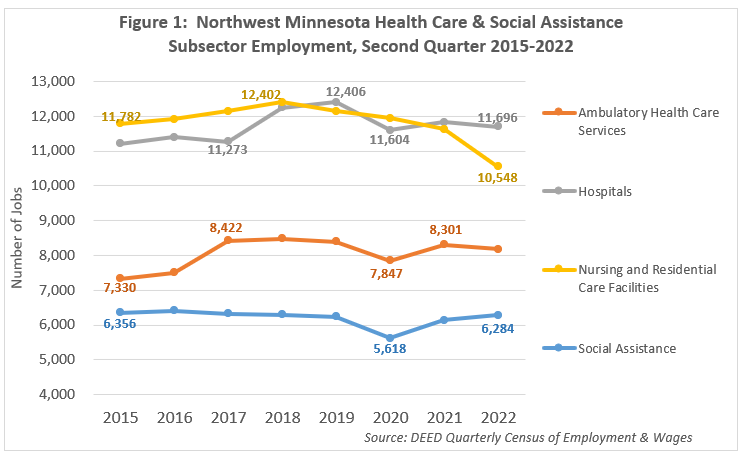 The presence of such industry powerhouses as Polaris, Arctic Cat and New Flyer make Northwest Minnesota a hub of transportation equipment manufacturing.
The presence of such industry powerhouses as Polaris, Arctic Cat and New Flyer make Northwest Minnesota a hub of transportation equipment manufacturing.
From wheat and potatoes to soybeans and sugar beets, the region is a major producer and processor of food staples and specialty agricultural products.
Want the freshest data delivered by email? Subscribe to our regional newsletters.
12/14/2022 9:00:00 AM
Anthony Schaffhauser
New data for the second quarter of 2022 was recently released from the Quarterly Census of Employment and Wages program, providing an opportunity for a fresh look at employment trends in Health Care & Social Assistance, which is the largest industry sector in the Northwest Minnesota region and statewide. As of second quarter 2022, Northwest Minnesota total employment is within 3.9% of the second quarter 2019 pre-pandemic peak, while the Health Care & Social Assistance sector is still down 6.3%.
Lagging growth in Health Care & Social Assistance marks a stark divergence from the prior trend. In the three years before the pandemic, Health Care & Social Assistance grew 5.2% from second quarter 2016 to 2019, more than two-and-a-half times faster than the 1.9% growth in total employment. Looking at the change in employment by subsector, we see that growth was driven by the 8.8% job gain (+1,006 jobs) for Hospitals and the 11.7% job gain (+881 jobs) for Ambulatory Health Care Services, which includes offices of doctors, dentists, and other health practitioners (see Figure 1.)

As the recession hit in second quarter 2020, employment across all industries dropped much more dramatically over the year (-11.1%) than in Health Care & Social Assistance (-5.5%).
In Health Care & Social Assistance, Hospitals lost the largest number of jobs, an 802 job decline, as procedures that could be deferred were postponed. Social Assistance had the largest percentage drop of -9.9%, while Ambulatory Health Care Services had an above average drop of -6.4%. Nursing & Residential Care had the smallest decline of 196 jobs, or -1.6%, less than the 256 jobs lost from 2018 to 2019.
Coming out of the recession from second quarter 2020 to second quarter 2021, total employment sprung back 7% while Health Care & Social Assistance regained only 2.4%. However, the subsector changes varied widely, with a 1.9% gain for Hospitals, a 5.8% increase for Ambulatory Care Services, and a 9.3% job jump for Social Assistance, while Nursing & Residential Care Facilities employment continued to decline in 2021, losing 316 jobs or -2.6%.
The largest employment declines for Nursing & Residential Care Facilities occurred between second quarter 2021 and 2022, with a decline of 1,086 jobs or -9.3% over the year. While this is the bulk of the 1,200 jobs lost in Health Care & Social Assistance from second quarter 2021 to second quarter 2022, the 121 jobs lost in Ambulatory Health Care and the 134 jobs lost in Hospitals are worth noting as well, declining -1.5% and -1.1%, respectively. Nonetheless, these two subsectors remain well above the pandemic lows. Social Assistance employment increased by 141 jobs or 2.3%, putting it in line with pre-pandemic levels, albeit below the levels in 2015 through 2018.
This over-the-year drop in Nursing & Residential Care Facilities employment is exceptionally large. This subsector has been facing an unprecedented struggle with recruitment and retention of nursing assistants that provide the direct resident, tenant, and client care. The largest effects on employment have been felt as the labor market recovered from the pandemic and so many competing job opportunities with increased pay became available. This is not isolated to Northwest Minnesota. Every region had significant drops in Nursing & Residential Care, but Northwest had the largest percentage drop.
To address the need for workers, the state of Minnesota has been facilitating wage increases through American Recovery and Protection Act funding and adjustments to Medicaid funding to facilities. Wages have increased substantially throughout the state, with average weekly wages at Nursing & Residential Care Facilities in Northwest Minnesota increasing from $604 in first quarter 2021 to $760 in second quarter 2022. This 25.8% increase does not translate into an hourly rate of pay increase because the average number of hours worked has also been increasing substantially. We will have to await the release of Quarterly Employment Demographics data for 2022 to learn how much hours worked and hourly wages have increased in Northwest Minnesota.
In the meantime, Current Employment Statistics provide a first look statewide. Hours worked in Nursing & Residential Care Facilities started increasing after first quarter 2021, going from 29.3 hours per week to 30.6 in first quarter 2022, a 4.4% increase. Average hourly wages increased from $18.90 per hour to $21.60, also from first quarter 2021 to first quarter 2022, a 14.4% increase. The Nursing & Residential Care Facilities subsector is making a substantial adaptation where fewer workers are working more hours while earning higher pay to provide the needed care.
On the surface, it appears that the Health Care & Social Assistance sector is lagging the recovery of the overall labor market coming out of the pandemic. But at the subsector level, Social Assistance is back to pre-pandemic employment levels, and Ambulatory Health Care Services is within 2.5%. Employment at Hospitals is still down -5.7% from pre-pandemic levels, further than the -3.9% gap for the region's total employment, but less than the -6.3% gap for the Health Care & Social Assistance sector overall. Instead, this sector's employment is greatly influenced by drastic changes in Nursing & Residential Care Facilities, which is adapting to provide care with fewer workers.
Contact Anthony Schaffhauser at 320-441-6594.